Flexcon Helios Overview
Introduction
Flexcon Helios is a third-party FlexSim module designed to help existing FlexSim users easily integrate energy use analysis into their simulations and digital twins. It allows users to simulate, analyze, and predict:
- Energy consumption and power requirements
- Indirect carbon emissions from energy use
- Costs proportional to energy consumption
Flexcon Helios is developed and supported by Flexcon S.r.l..
To learn about the latest updates and features, visit the What's New page.
To get started with a practical example, follow the Tutorial.
Key Concepts and Use Cases
Energy use analysis must account for not only how much energy is consumed by each individual system component, but also when and where it is used.
- Simultaneous consumption by different components of the system increases peak power requirements, potentially necessitating additional infrastructure capacity and investments.
- Variable availability and costs of some energy sources mean that accessing cleaner or cheaper energy may require more careful planning.
Discrete Event Simulations in FlexSim model system behavior over time, predicting when and where something happens and how system components interact with each other. Flexcon Helios allows you to define how much power is required for each component. With this approach, the total energy consumption can be analyzed in the context of other performance measures of the process. You can specify power requirements of FlexSim objects using the Energy Use Policy tool.
In many scenarios, energy costs, availability, and carbon intensity change over time. Some systems may also have on-site generation capacity or energy storage. FlexSim simulations make it possible to model this variability and integrate dynamic energy consumption with dynamic energy generation and delivery. By cross-referencing energy use patterns with costs and carbon intensity data, these simulations can estimate total energy costs and indirect carbon emissions. You can model energy availability, costs, and carbon intensity using Energy Source objects.
Flexcon Helios can provide significant value in at least three usage scenarios:
- Energy accounting in a simulation of a complex process: Understand when, where, and how much energy is consumed, estimate the overall power requirements of the production system and its components, and improve energy use efficiency.
- Estimating and optimizing indirect carbon emissions and costs from energy use: Conduct sustainability analysis, focusing on carbon emissions, system performance, and operating costs.
- Rightsizing energy components: Optimize and plan the infrastructure required to support the process.
By default, Flexcon Helios acts as an observer of the business process model. It assesses energy use in the process but does not change its outcome. This approach enables the gradual introduction of energy use simulations into existing FlexSim models.
Components
Energy Consumers
Most FlexSim objects have a state, which is a categorical tracked variable used to collect state history for each object. For example, a Processor usually alternates between such states as: idle, setup, processing, blocked, waiting for operator, and waiting for transport. Additional states such as breakdown or scheduled down can be activated through the use of the MTBFMTTR and Time Table tools.
Any persistent FlexSim object with a state can be an energy consumer. Flexcon Helios assumes that:
- Energy consumption rate (power) depends on the state and the content of the consumer object.
- Energy consumption rate (power) remains constant for the entire duration of the object state. Power curves are piecewise constant step functions.
Energy Use Policies
Energy Use Policy is a tool that defines a mapping between possible states of an object and their consumption rates. It usually defines power requirements for a group of similar objects consuming energy for the same purpose. Energy Use Policy collects and aggregates statistics about their consumption.
At the core of the Energy Use Policy is a table of the power requirements for each possible state of the connected consumer objects:
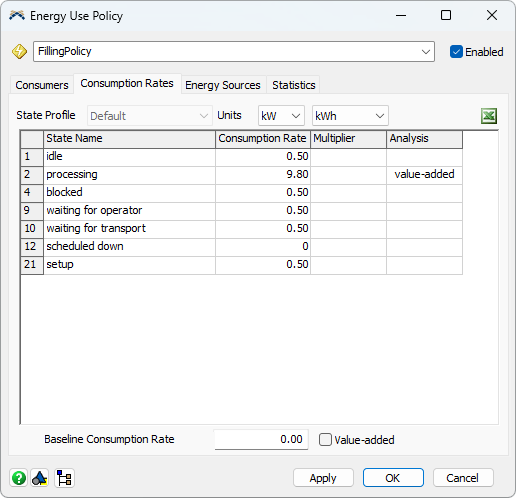
An object can be connected to any number of Energy Use Policies, and an Energy Use Policy can calculate the aggregate energy consumption for any number of consumers.
Energy Sources
To analyze the energy mix, costs, and indirect emissions of the business process, we need to define what energy is available at any given time.
An Energy Source is a 3D object that models when and how much energy is available, along with its associated costs and carbon intensity. An energy source can represent either an on-site generation capacity or an off-site energy supplier. It can also represent a delivery point or a distinct power subsystem. Each source may have a maximum available capacity (possibly stochastic), its own availability, carbon intensity, and cost schedules (possibly periodic). Like most FlexSim objects, the availability of Energy Sources can also be controlled by the MTBFMTTR and Time Table tools.
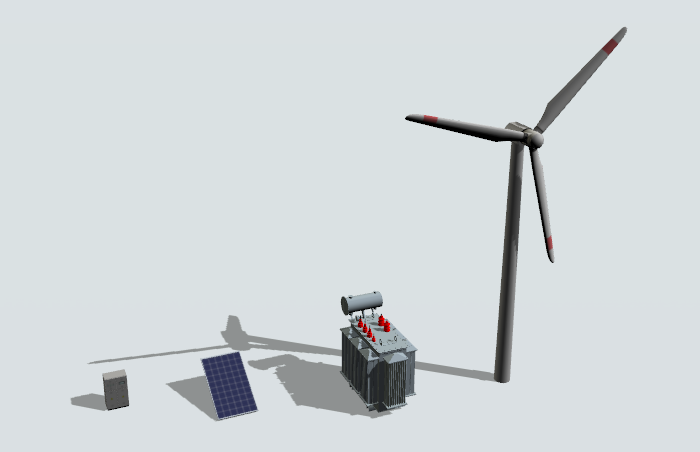
Periodic or scheduled availability of the Energy Source can be defined via a Generation Time Table:
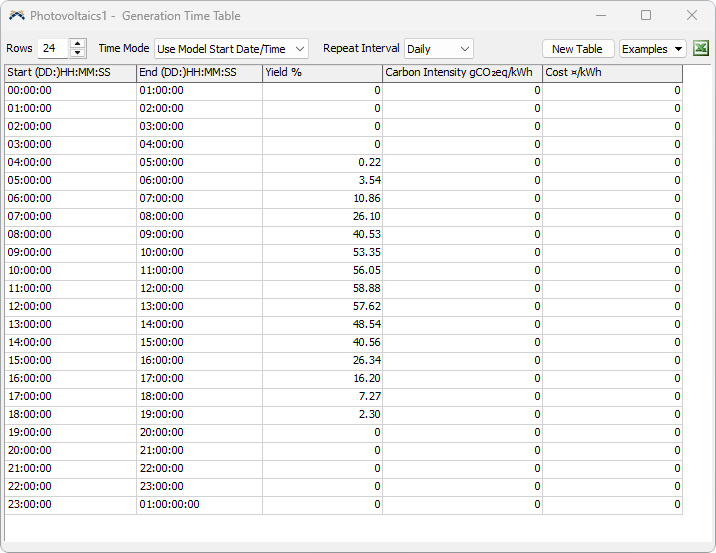
Energy Sources provide power to Energy Use Policies. The role of Energy Use Policies is to balance the load between multiple Energy Sources according to their priority. An Energy Source can provide power to any number of Energy Use Policies, and an Energy Use Policy can use more than one Energy Source.
Dashboard Chart Templates
Flexcon Helios extends the Dashboard Library with Chart Templates tailored specifically for energy use analysis. They are grouped into three categories based on the type of objects they analyze:
- Energy Sources
- Energy Use Policies
- Energy Consumers
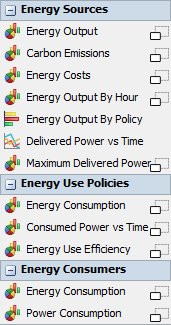
Energy Sources chart templates should be connected to Energy Source objects and can be used to analyze their power and energy output, as well as carbon emissions and costs.
Delivered Power vs Time chart shows every variation of power output, while Energy Output by Hour aggregates energy output over short periods of time.
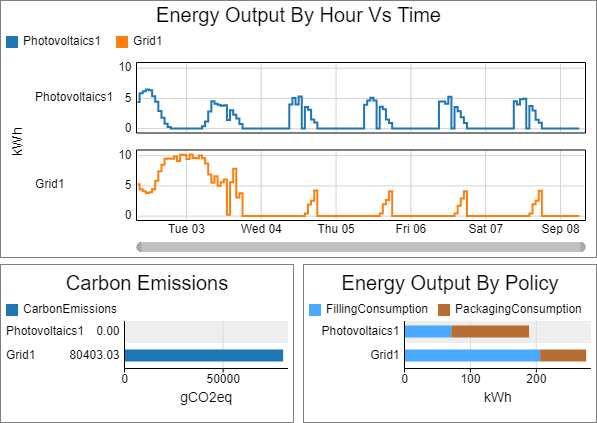
Energy Use Policies chart templates should be connected to Energy Use Policy tools, which can be found in the Toolbox. They can be used to analyze total consumption and energy use efficiency by policy.
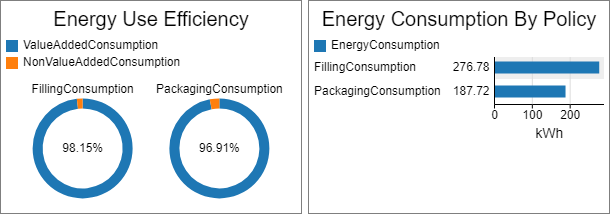
Consumed Power vs Time chart may be used to compare aggregate power requirements of different policies over time.
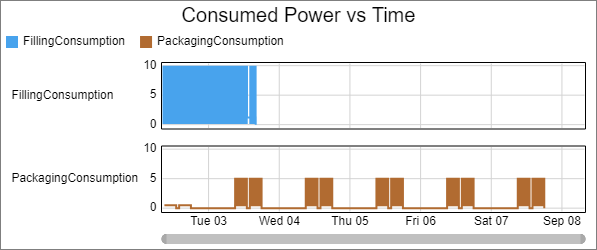
Energy Consumers chart templates should be connected to consumer objects. They can be used to analyze total consumption and power requirements by individual consumer.
